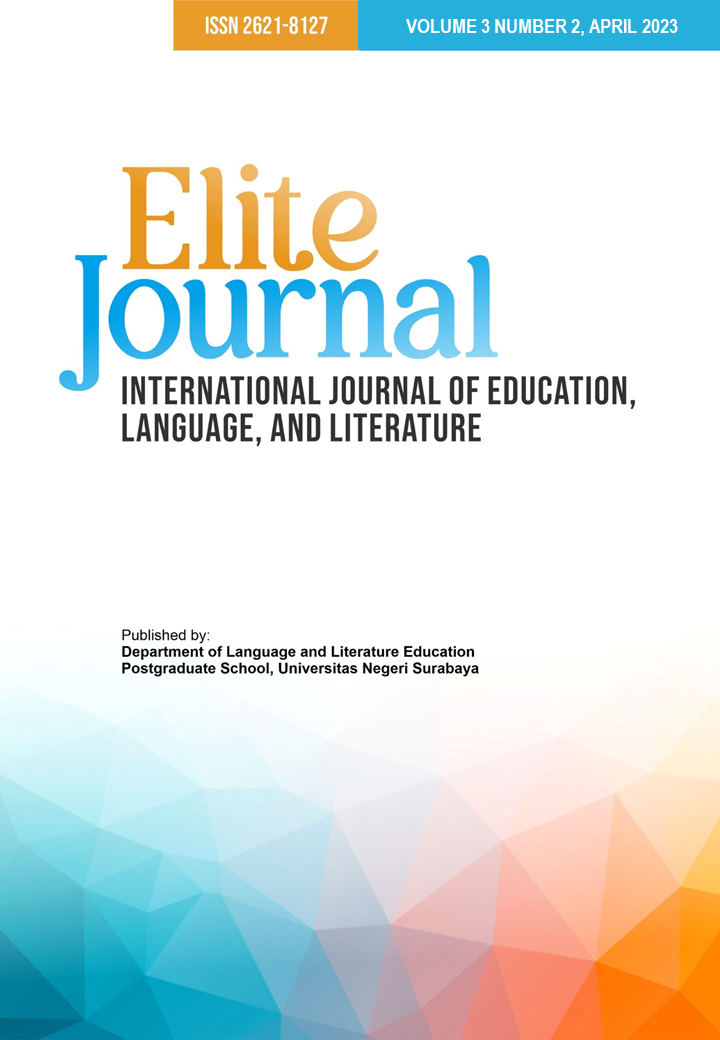AN ANALYSIS OF STUDENTS' STRATEGIES IN PUBLIC SPEAKING SUBJECT BY USING STRATEGY INVENTORY FOR LANGUAGE LEARNING (SILL)
DOI:
https://doi.org/10.26740/elitejournal.v3n2.p96-108Keywords:
Keywords: student learning strategies, SILL, Metacognitive, second semester students.Abstract
This research aims to determine student learning strategies in learning English in public speaking subject through the Inventory Strategy for Language Learning (SILL) for second semester EFL students. The method used in this research was a descriptive quantitative approach. The population in this research was students in the second semester of English education, and the subjects of this study were 30 students of second semester of the English education study program for the 2021/2022 academic year at the University of PGRI Silampari. The data collection technique of this research used a questionnaire. The data analysis technique used in this research was the basic statistical technique of percentages using a likert scale questionnaire. The results of this research indicated that there were 11 students who used the "Metacognitive" learning strategy, 5 students used the "Cognitive" learning strategy, 8 students used the "Compensation" learning strategy, 6 students used the "Affective" learning strategy, 7 students used the "Social" learning strategy, there are no students used the "Memory" learning strategy.
Keywords: student learning strategies, SILL, Metacognitive, second semester students
References
Alfarisy, F. (2022). The Use of SILL Oxford on Understanding the Speaking Learning Strategies. International Journal of Linguistics, Literature, and Translation, ISSN :2617-0299. doi:10.32996/ijllt.
Brown, H. D. (2007). Principles of Language Learning and Teaching (5th ed). White Plains. New York: Pearson Longman.
Cameron, L. (2001). Teaching Languages to Young Learners. Cambridge: Cambridge University Press, 40-41.
Gareis, E. (2006). Guidelines for Public Speaking. New York: Weismann School of Art and Sciences
Kazi, C. (2012). Essential of Public Speaking (5th ed.). USA: Cengage Learning
Kazi, A. S. (2017). Using Language Learning Strategies for Teaching Second or Foreign Languages. 32( 2), 10-25.
Lee, J., & Heinz, M. (2016). English Language Learning Strategies Reported By Advanced Language Learners. Journal of International Education Research 12 (2), 67-76.
Mun Yee, K., & Abidin, M. J. Z. (2014) The Use of Public Speaking in Motivating ESL Learners to Overcome Speech Anxiety. International Journal on Studies in English Language and Literature (IJSELL). Vol. 02(11),127.
McDonough, J., & Shaw, C., Masuhara H. (2003). Materials and Methods in ELT (2nd ed.). Oxford: Blackwell Publishing Ltd.
Mufanti, R., Nimasari, P. E., & Gestanti, R. A. (2017). Can I Be A Public Speaker?: Get Ready For Speech (2nd ed.). Ponorogo: CV. Nata Karya
Oxford, R. L. (1990). Language Learning Strategies: What Every Teacher Should Know. Boston: Heinle & Heinle Publisher.
Pollard, L. (2008). Teaching English: A Book to Help You through Your First Two Years in Teaching.
doi:10.26555/adjes.v9i2.82
Schreiber, L., Hartranft, M. (2017). Fundamentals of Public Speaking. California: College of the Canyon.
Shi, H. (2017). Learning Strategies and Classification in Education. Institute for Learning Styles Journal 1(1).
Downloads
Published
How to Cite
Issue
Section
License
Copyright (c) 2023 Widiya Juliyanti Suwarno, syaprizal, Maria Ramasari

This work is licensed under a Creative Commons Attribution 4.0 International License.
 Abstract views: 446
,
Abstract views: 446
, PDF Downloads: 362
PDF Downloads: 362





